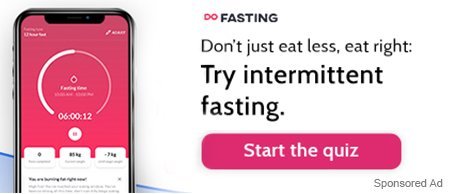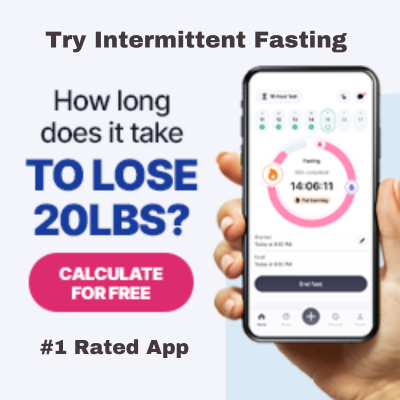What Causes Belly Fat | Intermittent Fasting | Intermittent Fasting & Belly Fat | Tips for Intermittent Fasting for Belly Fat Weight Loss
Belly fat or abdominal fat is something that many of us are all too familiar with. I like to think of it as an unwelcome guest that tends to overstay its welcome. Infamous for being a stubborn or problematic area, it’s a classic characteristic of what some refer to as the “dad bod”. Yet, it doesn’t just affect dads. We will go over Belly Fat and Intermittent Fasting, and what the correlation is between the two.
Recent data from the National Health and Nutrition Examination Survey found that 59% of US adults have abdominal obesity. And, the trend keeps going upwards for both males and females. The older we get, the higher our fat to body weight ratio is and before we know it, we’ve added quite a few pounds specifically around the belly.
That’s the bad news. The good news is that belly fat isn’t totally out of our control. We can take charge of our bodies and health to move in a positive direction. With dedication, hard work and the techniques we will share below, you can finally get rid of stubborn belly fat. Give that unwelcome guest an eviction notice and end the constant struggle. It may not be as hard as you think.
Will Intermittent Fasting Reduce Belly Fat?
Short answer is YES, when you follow an intermittent fasting protocol along with a healthy diet and exercise. Be sure to monitor your calories in and calories out, and determine your baseline daily caloric need. But there are other factors involved to ensure success.
One strategy that has shown to be effective in belly fat reduction is Intermittent Fasting. Intermittent Fasting is the not-so-secret weapon that has exploded in popularity over the last few years. From weight loss to improvement in cholesterol, the benefits to Intermittent Fasting are clear. More recently, Intermittent Fasting has been used as a way to lose belly fat.
Below, we’ll dive deeper into the causes of belly fat, how Intermittent Fasting helps with belly fat, tips to start Intermittent Fasting, and a few other ways to help eliminate belly fat.

What Causes Belly Fat?
First, it’s important to define belly fat. We’ve established that belly fat and abdominal fat refer to excess weight around the midsection. But, there is more to the story than what you see from the outside. There are two main types of fat in the body: visceral and subcutaneous.
Subcutaneous fat is the fat that you can “see” in your body. If you can pinch an area of fat between your fingers, it is likely the subcutaneous type of fat. It’s the fat that lies just beneath the skin. While some subcutaneous fat is necessary for energy reserves and body temperature regulation, excess subcutaneous fat isn’t good for overall health. However, subcutaneous fat is much less of a threat to your body compared to visceral fat.
Visceral fat is that fat that lies in the space around your abdominal organs. It can’t be seen outside the body and collects around important organs such as the stomach, liver, and intestines. Because of its close proximity to really important organs, visceral fat is much more of a threat than subcutaneous fat.
Excess subcutaneous fat is often a good indicator that there is too much visceral fat. Recently, it was discovered that these fat cells are biologically active and can even produce their own hormones, disrupting the body’s natural balance and affecting other tissues. There are many potential risks to large amounts of visceral fat including:
- Heart disease
- Type 2 diabetes
- High blood pressure
- High cholesterol
- Dementia
- Certain cancers
Certain factors contribute to why belly fat likes to hang around. This is because of certain lifestyle factors, hormones, medication and genetics.
Genetics play a role in fat distribution, or what area of the body we tend to gain weight. While there isn’t much you can do about your genetics, you do have control over lifestyle choices. These lifestyle factors include a diet that is high in refined sugar and fatty foods, little to no exercise, and high levels of stress.
Keep reading to learn ways to get rid of belly fat and lose weight by working on some of these lifestyle factors.
Intermittent Fasting
Intermittent Fasting has been used as a weight loss tool for many years. The basic idea of Intermittent Fasting is that there is a limited number of hours each day in which you consume all of your calories.
The remaining hours are considered a fasting window where nothing is eaten. When most of your day is spent in a fasting state, it allows your body to burn more calories. Intermittent Fasting is a schedule for when you are eating, but there aren’t specific foods that are required.
A healthy diet consisting mainly of whole, unprocessed foods is encouraged when practicing Intermittent Fasting.
Intermittent Fasting is popular because it can be adapted to fit an individual’s lifestyle and schedule. There are many different types of Intermittent Fasting and it’s best to choose one that fits with your schedule. This will lead to more consistency when following your fasting and eating windows and better results.
One of the most popular types of Intermittent Fasting is the 16/8 type. With this schedule, you are fasting for 16 hours of the day and eating during an 8 hour window. These hours fit in with the average person’s natural clock as most will skip breakfast to achieve the full 16 hour fast. See our full guide on 16/8 Intermittent Fasting here.
Here are some other types of Intermittent Fasting if you want to explore more options:
- 14/10
- 5:2
- 23/1 Intermittent Fasting a.k.a. One Meal a Day (OMAD)
- Alternate Day Fasting
- 20/4 a.k.a. The Warrior Diet
Many have used Intermittent Fasting as a way to lose weight and improve health markers. The benefits range from weight loss, improved insulin sensitivity, and reducing the risk of type 2 diabetes.
But, did you know that Intermittent Fasting is a game changer for losing belly fat as well? This is because of the unique way that Intermittent Fasting works in weight loss and restoring hormonal balance.

How Intermittent Fasting Helps with Belly Fat
So, you may be thinking, how exactly can Intermittent Fasting help me lose belly fat? First let’s start with what happens when we eat. Most of the calories we eat are broken down into the body’s preferred energy source, glucose.
When we have more glucose than we need for energy, it is stored in our muscles and liver as glycogen. When glycogen stores are full, the body then converts extra glucose into stored fat. Many of these fat stores are located in the abdominal region, aka belly fat.
Intermittent Fasting is unique in that it specifically targets these fat stores. When fasting, the body doesn’t have a constant supply of glucose for energy, so it will then turn to glycogen. Once those are used up, the body will turn to fat stores for energy.
These fat stores are accessed via fatty acid which the liver turns into ketones to provide energy. This metabolic switch from using glucose from food into using stored glycogen and fat happens around 12 hours after eating has ended.
This is how Intermittent fasting taps into this metabolic magic. By fasting for a minimum of 12 hours, your body has a chance to rest from the continuous building up of fat stores and actually use up some of the previously stored fat.
Another way that Intermittent Fasting helps with belly fat is through the effect that it has on hormone levels. Insulin in particular is an essential hormone that regulates blood sugar. Visceral fat often leads to insulin resistance and therefore poses a higher risk for developing type 2 diabetes.
Insulin resistance occurs when there are chronically high levels of glucose in the bloodstream which then leads to chronically high levels of insulin. Insulin’s main job is to bring glucose out of the bloodstream and into cells.
Over time, our cells become desensitized to the constantly high levels of insulin and it no longer effectively transports glucose into cells. During a fasting window, insulin levels are able to drop and the cells’ sensitivity to insulin can improve or return to normal.
Leptin is another hormone that plays a role in weight loss and belly fat. Its job is to signal to the central nervous system to adjust food intake and energy expenditure. The weight loss that occurs by Intermittent Fasting also results in improvement in leptin levels which affects appetite control.

Intermittent Fasting for Mom Belly
We get asked a lot… What if i just had a baby, how do I get rid of the “mom belly”. Well, intermittent fasting has also been known to improve this as well. When practicing intermittent fasting regularly, yes you can reduce that belly! Now there are some challenges, mom belly can be a different situation, due to recovery from birth. But in general, taking small steps like intermittent fasting, and eating health whole foods, you can get that mom belly back to normal in no time!
Tips for Intermittent Fasting for Belly Fat Weight Loss
Maybe you are ready to try Intermittent Fasting to get rid of stubborn belly fat. The good news is that you can get started right away. It doesn’t require any special supplements or equipment to start. All you need to do is plan which hours you will be fasting and what will be your eating window. If you’re brand new to Intermittent Fasting, it’s best to start slow and steady. Start out with a 12 hour fast and see how that works with your lifestyle and schedule. You may find yourself moving into 14, 16, 18, or 20 hour fasts fairly quickly once you have adjusted to the initial 12 hour fasting schedule.
Here are some tips to keep in mind to successfully practice Intermittent Fasting:
Consistency is key
You won’t see nearly the same benefits if you practice Intermittent Fasting one day and then return to your regular eating habits the next. It’s best to stick with Intermittent Fasting for at least 21 days to start seeing the benefits.If you need more motivation to stay consistent, check out this 21 day Intermittent Fasting challenge.
Listen to your body
Some days will be better than others but that doesn’t mean you have to give up. It’s still important to nourish your body with enough calories to support your energy needs. If you find that you are unable to fit enough meals in, try to plan your eating and fasting hours around what works best for your schedule. You may need to think about things like work or exercise routines when determining the best times for an eating window.
Eat the right foods
It’s important to still be mindful of the foods you eat while Intermittent Fasting. Choosing whole, nutrient-dense foods will enhance the benefits of Intermittent Fasting. Foods such as fruits, vegetables, legumes, lean protein, whole grains, and healthy fats are all important to include for a balanced diet. Avoid highly processed foods, foods high in saturated fats and sugar-sweetened beverages.
It’s important to keep in mind that other lifestyle changes can also help reduce belly fat. Things like regular, moderate exercise, stress reduction, and sleep quality all play a role in reducing belly fat. There are several lifestyle tweaks that will support your goals, whether that is more exercise, stress reduction, or aiming to get more sleep.
Intermittent Fasting provides several benefits, especially if you’re aiming to use intermittent fasting to lose belly fat. It is a simple way to kickstart your metabolism, balance hormones, and aid in weight loss. While it is a simple method, it will take a bit of planning and effort to achieve results.
However, investing in your health is always worth it. If belly fat has been something you struggle with, it may be time to try Intermittent Fasting and start prioritizing your health journey.
Need an APP on your Mobile to help with Fasting? See our Top 6 FREE and Premium Fasting Apps
Want to know what you can Drink While Fasting? What Can You Drink during Fasting Page














